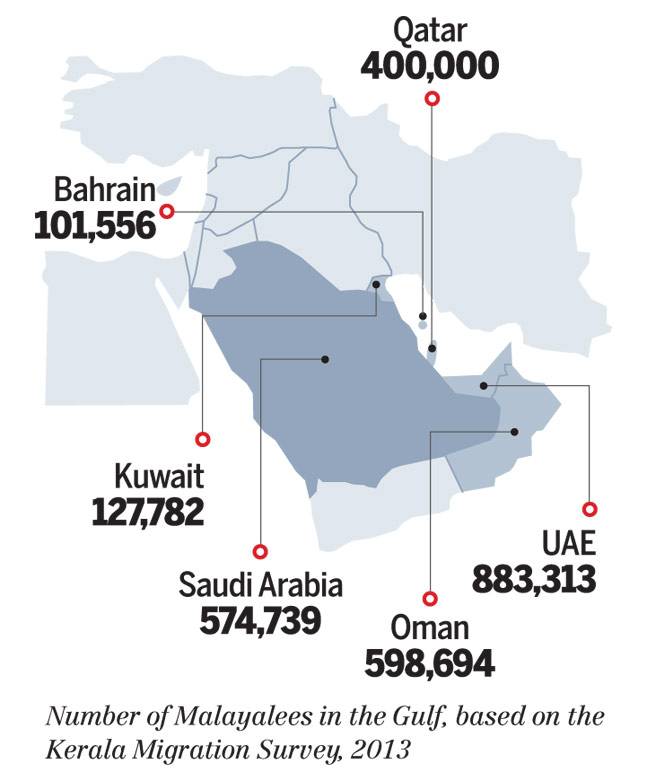Migration: India
This is a collection of articles archived for the excellence of their content. |
Contents |
HNW individuals’ migration
How The Rich Buy New Nationalities; 2017 figures
How The Rich Buy A New Nationality, July 30, 2018: The Times of India
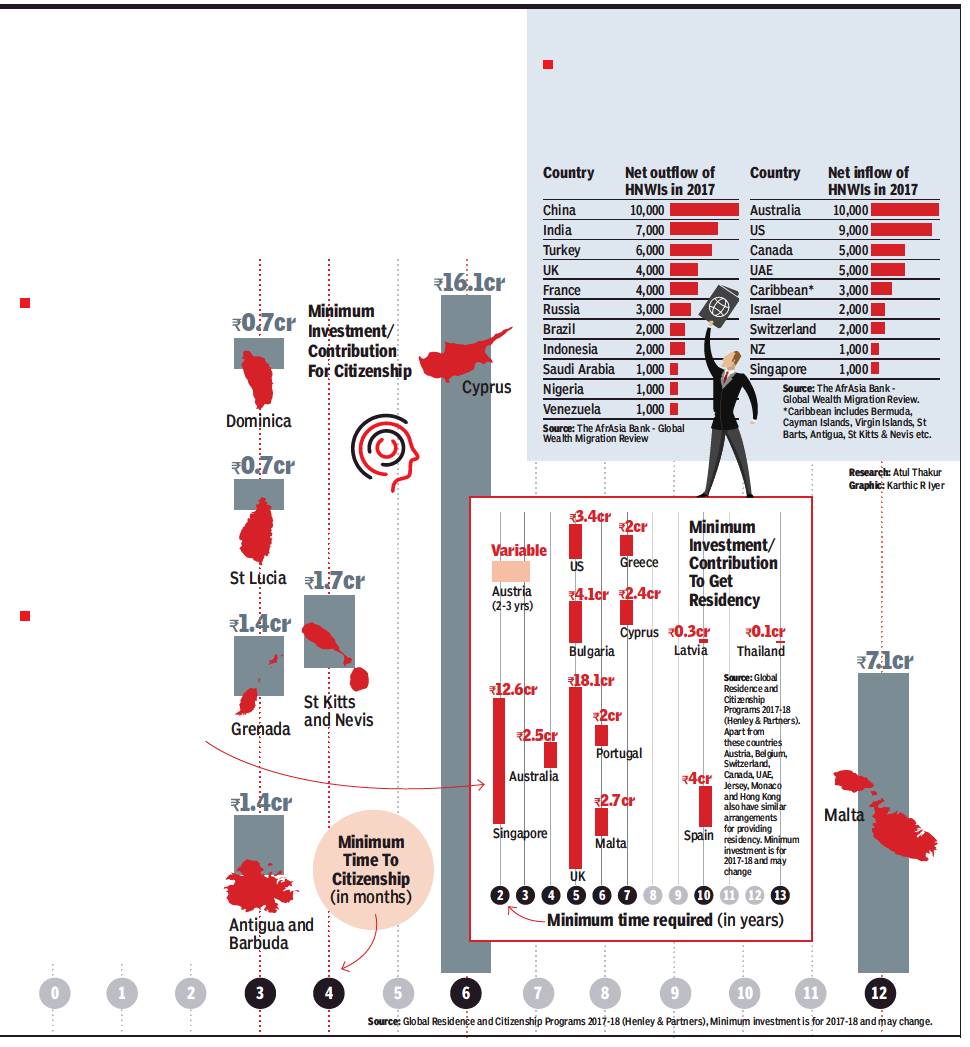
ii) THE countries that they migrate to.
From: How The Rich Buy A New Nationality, July 30, 2018: The Times of India
Fugitive Mehul Choksi bought Antiguan citizenship, and his new passport allows him visa-free entry to over 130 countries. TOI takes a look at how the rich can buy their way to new citizenship and residency
Can citizenship be acquired by investing?
Acquiring citizenship need not be a long-drawn process. Not all nations need you to prove years of residency. Many countries offer the wealthy citizenship-by-investment programmes. This method of granting citizenship was seen as controversial when Caribbean island St Kitts and Nevis pioneered the idea in 1984. But today many countries have followed suit to offer citizenship to well-heeled individuals who donate a fixed amount to the government of their new home or invest over a certain level.
Can permanent residency be acquired by investing?
Many countries that don’t provide citizenship but grant residency to the wealthy if they invest above a certain amount in the local economy. Residency provides unlimited stay and rights enjoyed by locals. These may include benefits like healthcare coverage and the right to work or study. Such residents cannot vote and are not issued passports of their new home nation. Indians, for instance, can apply for Tier 1 (Investor) visa of UK if they are willing to invest GBP 2 million (INR 18.1 cr). Similarly, the process for a US Green Card can be expedited for an individual who invests USD 1 million (or USD 500,000 in rural areas with few jobs) and creates at least 10 new full-time jobs.
Where are the super-rich going and which countries are the biggest losers?
South Africa-based New World Wealth, a global market research group that specialises in wealth statistics, found China followed by India witnessed the highest migration of high net worth individuals (HNWIs) — people with net assets of US$1 million (Rs 6.9cr) or more. The largest recipient of these super rich migrants are Australia, US and Canada.
Immigration (into India)
2010, 2017: Migrants in India

From: February 5, 2019: The Times of India
See graphic:
2010, 2017: Immigrants living in India, China and major countries'
Gulf, Migration to
2013: Malayalis in the Gulf
See graphic:
No. of Malayalees in the Gulf
2014> 2018: Migration to Gulf for jobs drops 62%
Lubna Kably, January 12, 2019: The Times of India
Lubna Kably, UAE is top Gulf workplace for Indians, January 12, 2019: The Times of India
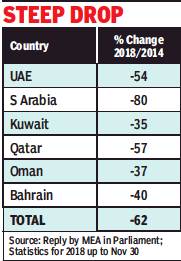
From: Lubna Kably, January 12, 2019: The Times of India
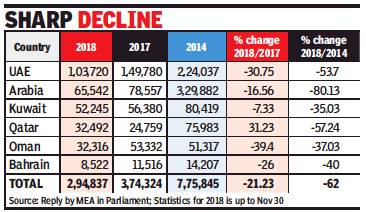
From: Lubna Kably, UAE is top Gulf workplace for Indians, January 12, 2019: The Times of India
The total number of emigration clearances granted to Indians headed to the Gulf, for employment, has dropped by 21% to stand at about 3 lakh during the 11-month period ended November 30, 2018, compared with the year 2017.
Over the past five years, during 2014, the outflow of Indian workers to Gulf was the highest at about 7.8 lakh. Compared with this figure, the decline in 2018 is as high as 62%. These statistics are drawn from the e-Migrate emigration clearance data, which captures the emigration clearances issued to workers holding ECR (emigration check required) passports.
Among all the Gulf nations, the largest outflow of Indian workers in 2018 was to UAE, with about 1 lakh (or 35%) of the total workers being granted emigration clearances. It was followed by Saudi Arabia and Kuwait with 65,000-odd and 52,000-odd workers headed to these countries.
In 2017, Saudi Arabia had relinquished its position as being the most attractive destination among Gulf countries for Indian workers. In its edition dated August 22, 2017, TOI had analysed the Nitaqat scheme for protection of local workers — the decline in expat workers, including from India is attributed to this scheme and the economic conditions.
Qatar stands out by being the only country in the Gulf region, where the number of workers shows an increase in 2018 as compared to the previous year. Nearly 32,500 workers headed to Qatar were granted emigration clearances, as compared to close to 25,000 in 2017, which is a rise of 31%.
“This could be because of increased labour requirement as the country prepares to host the World Cup, 2022” says a Mumbai based labour recruiter. However, there have been some reports of non-payment to Indian workers by unscrupulous employers, an instance of a construction agency not paying nearly 600 workers was recently in the spotlight. Washington headquartered think-tank, The Middle East Institute, says there are an estimated 6 to 7.50 lakh Indian migrant workers in Qatar, constituting the largest expatriate community and nearly double the number of native Qataris.
According to a reply given by the ministry of external affairs in Lok Sabha last December, there are several reasons for the decrease in numbers. “Prominent among them is that the Gulf countries are passing through a period of economic slowdown primarily because of the slump in oil prices.”
Illegal migration
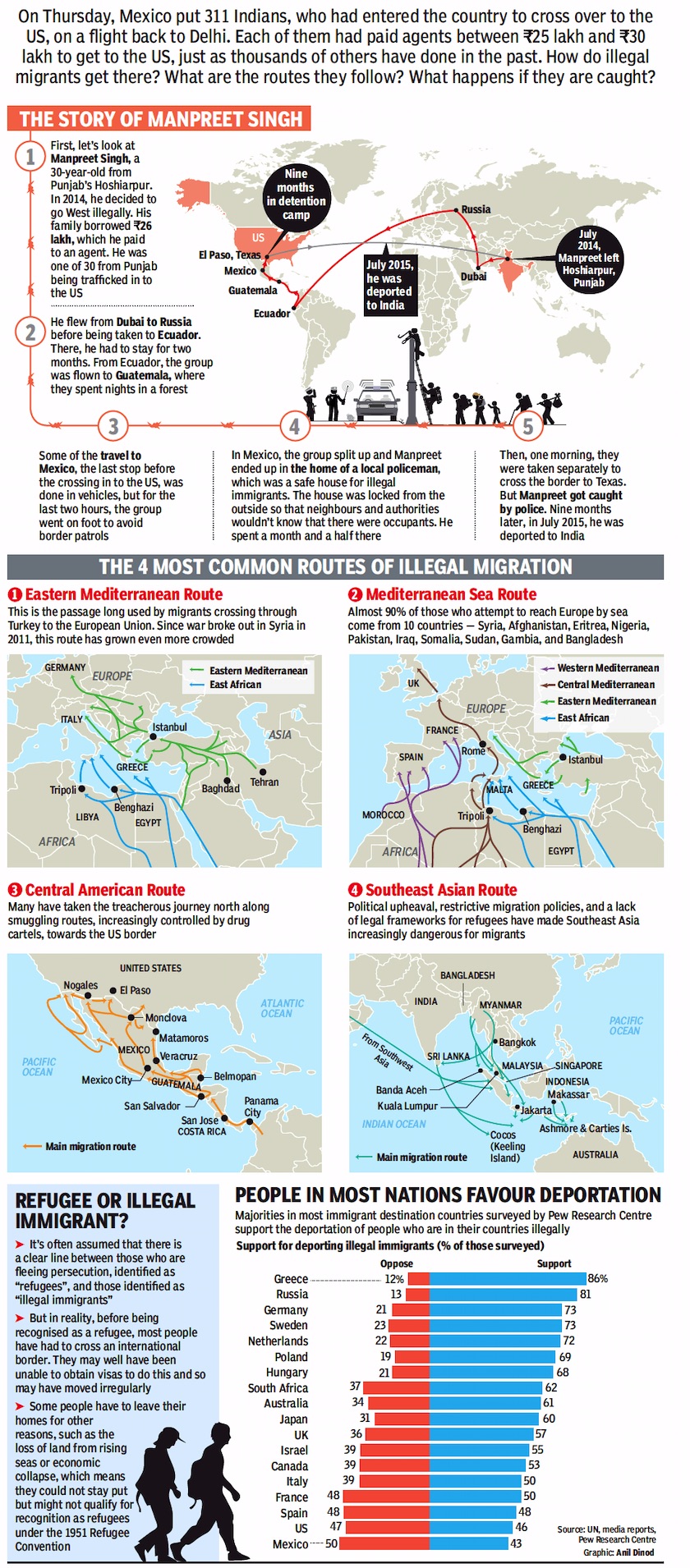
From: Oct 19, 2019: The Times of India
See graphic:
Some of the routes that Illegal Immigrants Take To Go West
Through Mexico
2019: Mexico deports 311 Indians
Oct 18, 2019: The Times of India
In a transatlantic deportation without precedent, Mexico has put 311 Indians caught illegally entering the country and trying to cross over to the US on a Boeing 747-400 charter scheduled to touch down at Delhi airport.
Mexico’s National Migration Institute (INM) said in a release that the deportees, who are being escorted back home by 60 federal migration agents, had been found to have entered the country without valid documents for “regular stay” over the past few months.
The mass deportation revived memories of the tragedy that befell a family from Punjab in June, when a six-year-old girl died of a heat stroke in the Arizona desert on the US-Mexico border after her mother went in search of water during their illegal border crossing. The body of Gurpreet Kaur was found after two Indian women apprehended by US border patrol revealed that a mother and her two children had been with them until a few hours earlier.
Sources said each member of the group possibly paid Rs 25-30 lakh to the agents who arranged their travel to Mexico and promised to help them illegally cross over to the United States.
Trump’s tariff threat on Mexican imports triggered deportation
The cost apparently included airfare, accommodation in Mexico and meals. The agents had purportedly cited a week to a month’s time to arrange their entry into the US, the sources said.
According to the Mexico’s National Migration Institute release, they were caught in Mexico without “papers for regular stay” and produced before immigration authorities in the states of Oaxaca, Baja California, Veracruz, Chiapas, Sonora, Mexico City, Durango and Tabasco. US President Donald Trump’s threat to impose tariffs on all Mexican imports if the country did not put a check on people illegally entering US through the porous borders forced its hand, sources said.
A source said the Boeing 747-400 that took off from Mexico’s Toluca City International Airport with 311 deportees was expected to land in Delhi at 5.45am on Friday.
“This operation was carried out thanks to the excellent communication and coordination with the embassy of that Asian country (Indian) with which the recognition and return of these citizens was worked under strict adherence to the migration law and its regulations,” the INM statement said.
The deportees were issued an “emergency certificate” each, which is a oneway travel document that allows an Indian citizen to enter India in an emergency. Such papers are issued to individuals who lose, damage or have no valid passports. INM said never before had Mexico carried out a deportation exercise of this scale.
Loans for migration
‘Dollariyo Pradesh’ in north and central Gujarat
Bharat Yagnik & Ashish Chauhan, February 3, 2022: The Times of India
Ahmedabad: Immigrating abroad is not easy, and if you must take a loan to achieve your dream, the process turns into a great burden. Yet, there’s a region in Gujarat where people planning to immigrate legally or even illegally cannot only avail themselves of a loan worth lakhs at 0% interest but also are under no obligation to return the money. While the beneficiaries do not have to pay EMIs, most of them usually pay much more than they received back to the community.
Ankit Patel, 21, from Kalol in Gandhinagar district wanted to go to the US but did not have the financial means to take a loan. He approached a local trust that pooled money from the community to finance youngsters who want to study abroad.
Within a week, the money was arranged. Once Ankit settled down in Pennsylvania, US, he returned double the amount he had taken as a loan back to the trust.
There are various such trusts in the region called ‘Dollariyo Pradesh’ in north and central Gujarat that financially help young men and women to pursue their desire to settle in foreign countries. According to locals, these trusts are informal and mainly run by local communities.
Bhavin Patel (42) is a resident of Dingucha, Gandhinagar, that recently came into the limelight after a family of four from the village froze to death while trying to illegally cross into the US from Canada. He said every family has at least one member in the US, Canada, or Australia. “This doesn’t mean everyone has the money to send their family members abroad. We have a trust in the village which collects money solely for sending people abroad,” said Bhavin.
Migration, outward, to all countries
1990-2019: Afghanistan, Bangladesh, India, Pakistan
Sep 23, 2019: The Times of India
Source: UN Department of Economic and Social Affairs; Graphic: Karthic R Iyer
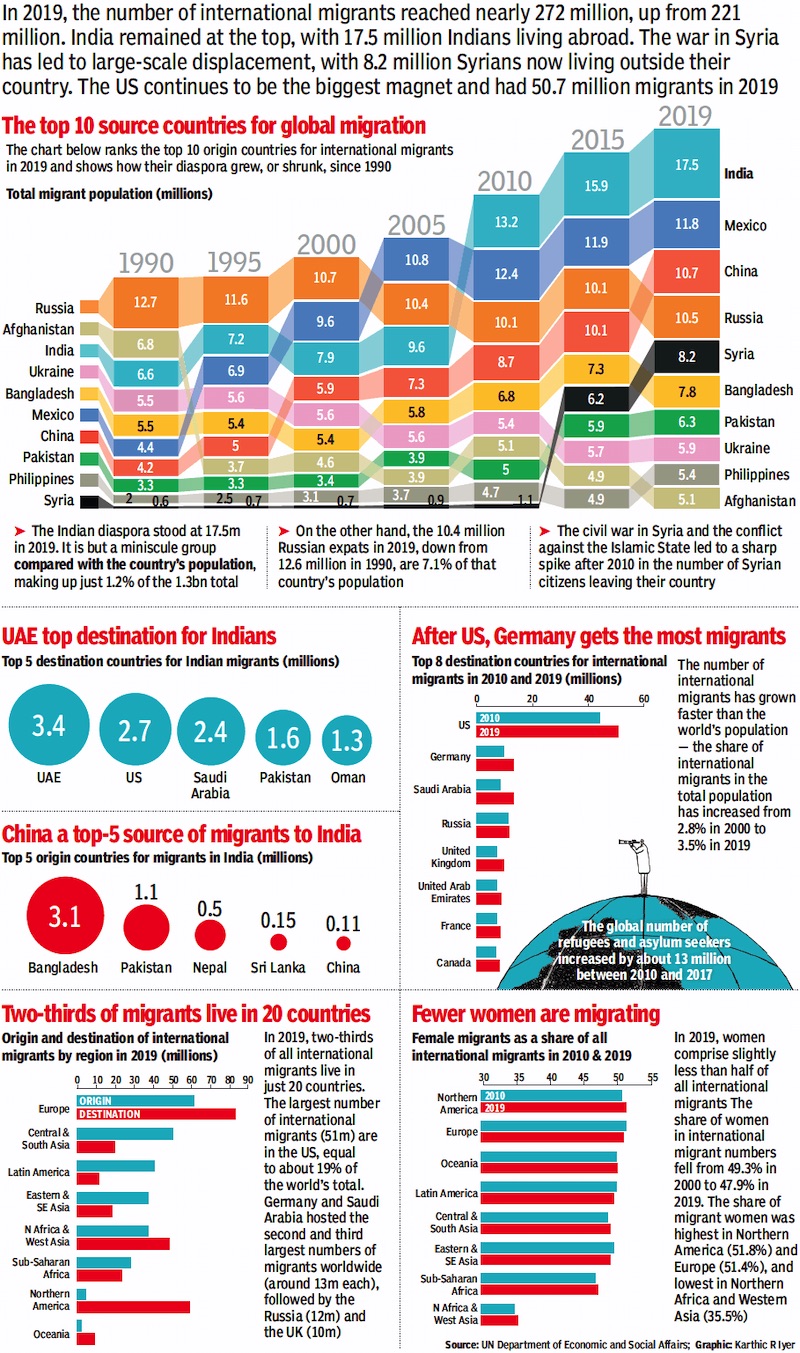
From: Sep 19, 2019: The Times of India
See graphic:
1990-2019: Outward migration from Afghanistan, Bangladesh, China, India, Pakistan and other countries.
In 2019, the number of international migrants reached nearly 272 million, up from 221 million in 2010, an increase of 51 million people or 23%. That's more global migrants than the number of children born each year. India remained at the top, with 17.5 million Indians living abroad.
The US continues to be the main magnet, hosting 50.7 million migrants in 2019, including a sizable and affluent Indian-American community — one of the reasons why US President Donald Trump attended Prime Minister Narendra Modi's 'Howdy Modi' mega rally in Houston, Texas, which witnessed an over 50,000-strong crowd. Not just Trump, other lawmakers — both Republican and Democrat — were also present, a sign that the Indian diaspora's vote in the 2020 US presidential election is important for both sides.
INDIA TOP ORIGIN COUNTRY FOR MIGRATION
But although India ranks at the top with a 17.5 million diaspora worldwide, it is only a minuscule group compared with the country's population, making up just 1.2% of the total 1.3 billion population. On the other hand, the 10.4 million Russian expats in 2019, down from 12.6 million in 1990, are 7.1% of that country's population.
In recent years, Syria has witnessed large-scale displacement owing to the civil war and the conflict against the Islamic State, leading to a sharp spike in migration after 2010 with 8.2 million Syrians now living outside their country.
The chart below ranks the top 10 origin countries for international migrants in 2019 and shows how their diaspora grew, or shrunk, since 1990.
UAE TOP DESTINATION FOR INDIANS
While the US has a large Indian diaspora, it is not the top destination for Indians who want to settle abroad. Gulf countries, particularly the UAE, continue to have a high concentration of Indians, although in recent years they've lost some of their drawing power due to nationalisation programmes, economic recession and the rise in living costs there.
CHINA A TOP-5 SOURCE OF MIGRANTS TO INDIA
India, meanwhile, hosted 5.1 million migrants this year. International migrants as a share of total population remained steady at about 0.4% from 2010 to 2019. China also made it to the top-5 list. But the maximum migrants to India came from Bangladesh. even as concerns over illegal migration from across the India-Bangladesh border persist.
AFTER US, GERMANY GETS THE MOST MIGRANTS
The number of international migrants grew faster than the world’s population in 2019 — the share of international migrants in the total population increased from 2.8% in 2000 to 3.5% this year. The US hosted the largest number of migrants at 51 million, equal to about 19% of the world's total, followed by Germany and Saudi Arabia (13 million each), Russia (12 million) UK (10 million) and UAE (9 million). Three out of every four international migrants are in the 20-64-year age group, a sign that the majority moved countries for better work opportunities.
TWO-THIRDS OF MIGRANTS LIVE IN 20 COUNTRIES
In 2019, two-thirds of all international migrants live in just 20 countries. Europe and North America absorbed the largest share — 82 million migrants live in Europe and 59 million in North America in 2019.
FEWER WOMEN ARE MIGRATING
Women comprised slightly less than half of all international migrants this year. The share of women in international migrant numbers fell from 49.3% in 2000 to 47.9% in 2019. The share of migrant women was highest in Northern America (51.8%) and Europe (51.4%), and lowest in Northern Africa and Western Asia (35.5%).
Outward migration from India
2017, 2018: to OECD countries
Lubna Kably, October 20, 2020: The Times of India
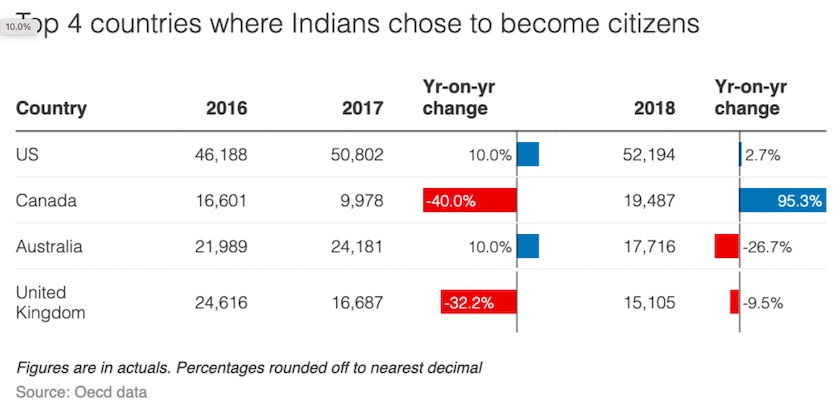
From: Lubna Kably, October 20, 2020: The Times of India
India world No. 2 in migrations to OECD nations, getting citizenships
MUMBAI: India has emerged as the second largest source country both in terms of the “total” inflow of new migrants to OECD countries during 2018 and also as regards the number of Indians acquiring citizenship of these countries. While China continued to retain its top slot as the largest source country, India replaced Romania to emerge as the second largest source. During 2018, about 4.3 lakh Chinese migrated to OECD countries, accounting for nearly 6.5% of the total migration inflows.
However, there was a slight decline of 1% as compared to the previous year. On the other hand, migration from India to OECD countries increased sharply by 10% and reached 3.3 lakh. Migration from India represents about 5% of the overall migration to OECD countries. While Canada saw a huge spike in numbers, others such as Germany and Italy also saw more arrivals as compared to the previous year.
Collation of country-wise data shows that the “total” inflow of new migrants to OECD countries was 66 lakh, a slight rise of 3.8% over the previous year. Data on migra tion flows by nationality may include temporary migration for some destination countries, clarifies OECD. The Organisation for Economic Co-operation and Development is an association of 37 member countries, such as European countries, US, Canada, Australia, New Zealand, and Japan.
As these are well-developed economies, they attract a large share of immigrants, be it for work, studies or even asylum. Before the pandemic, permanent migration flows to OECD countries (bar Colombia and Turkey that have hosted a large number of humanitarian migrants in recent years) was 53 lakh in 2019, with similar figures for 2017 and 2018. Permanent migration flows do not include temporary labour migration or international students.
While releasing the “International Migration Outlook 2020” at a virtual press conference on Monday, Angel Gurría, secretary general at OECD, said Covid-19 has redrawn the international mi gration map. Following the onset of Covid-19, almost all OECD countries restricted admission to foreigners. Issuances of new visas in these countries plummeted by 46% in first half of 2020 compared with the same period in 2019. This is the largest drop ever recorded. In the second quarter, the decline was 72%. The secretary general said migration would continue to play a key role for economic growth and innovation, and in responding to rapidly changing labour markets.
2015-16: Educated migrants
November 28, 2020: The Times of India
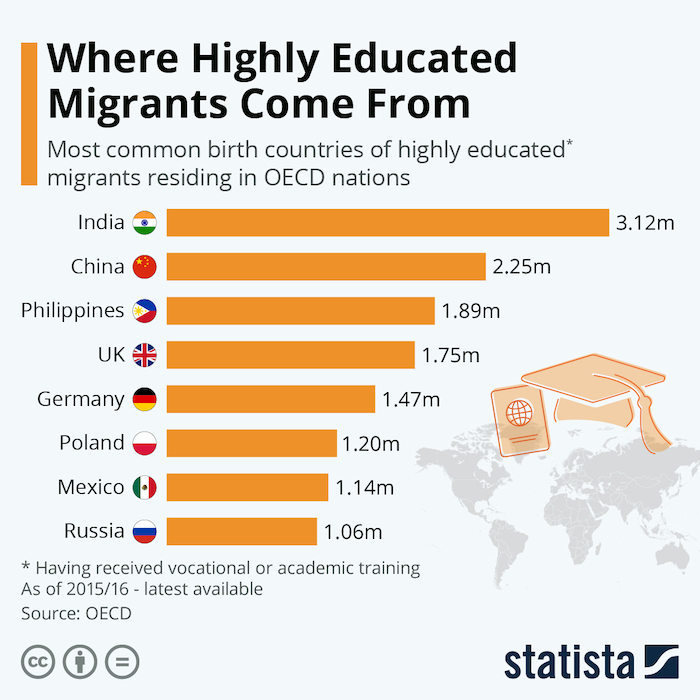
From: November 28, 2020: The Times of India
Indians top the list of educated migrants in rich countries OECD data reveals that there are around 120 million migrants living in OECD member countries. 30 to 35 percent of these migrants are considered highly educated, meaning they have received vocational or academic training. Among the most common birth countries for highly educated migrants, these shares are a lot higher, however.
For India, which topped the list as of 2015/16 with more than three million highly educated migrants in the OECD, the share of those considered of high education status was nearly 65 per cent. China had a rate of 48.6 percent highly educated migrants in the OECD – or 2.25 million.
The Philippines come in rank 3, behind the world’s two biggest countries and ahead of a list of OECD nations, naturally trading highly educated personnel back and forth with each other, especially within Europe. 53.3 percent of Filipino immigrants to the OECD are considered highly educated, which brings the total to almost 1.9 million for a country of just over 100 million inhabitants. In a paper on the Philippines, the International Labor Organization finds that many of those high skilled migrants - to OECD countries and elsewhere – were health care professionals, especially nurses. Because of the coronavirus pandemic, the Philippines government has put a stop to this brain drain at least temporarily by capping the deployment of newly hired nurses at 5,000 per year.
Around half of Filipino migrants in the OECD chose the United States, forming one of the most important migration corridors identified by the OECD, behind Mexican and Indian immigration to the United States and ahead of Polish immigration to Germany.
2017-21: Rich people, and others
Sunainaa Chadha, March 25, 2022: The Times of India
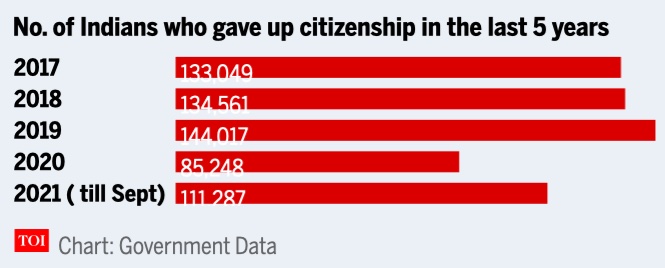
From: Sunainaa Chadha, March 25, 2022: The Times of India

From: Sunainaa Chadha, March 25, 2022: The Times of India
Indian nationals topped the charts for enquiries received by the firm in 2021 by a significant margin, with growth of 54% compared to 2020 — a year which itself saw a 63% rise in interest shown by Indian investors.
NEW DELHI: Ultra-high net worth individuals from India, the US and UK accounted for the bulk of investment migration inquiries in 2021, according to a report by residence and citizenship planning company Henley & Partners.
Indians accounted for the highest number of investment migration inquiries in 2021 and queries within this group surged 54 per cent annually.
Investment migration refers to wealthy investors acquiring alternative residence or additional citizenship in exchange for a substantial contribution to the host country.
Over six lakh Indians have given up their citizenship in the last five years, according to data by the ministry of external affairs, 40% of them being in the US. The overall number also included those availing a golden visa - where you invest in countries like, say Portugal, Malta or Cyprus in return for residence or citizenship.
Around 1,44,017 people gave up their Indian citizenship in 2019, which has been the highest in the last five years. The lowest was in 2020 at 85,248, and this is probably because of the Covid-19 pandemic. At 11,287 2021 saw the steepest spike in Indians giving up their citizenship as worldwide travel and outdoor restrictions started to ease. Point to note: Data for 2021 is only available till September 2021.
Statistics from the Global Wealth Migration Review show that 2% of India’s millionaires had already flocked overseas in 2020. While China topped the migration list with a total of 16,000 High Networth Individuals exits, India came in second at 7,000 exits, and Russia 5,500 exits.
So, where do India's super rich want to migrate to?
While Portugal tops the list, Malta and Greece also appear in the top 5 countries, Indians wants to move to.
“While India remains an exceptionally exciting place for business activities, commercial growth for corporations, and high-yielding investments, high-net-worth families are becoming increasingly cosmopolitan and transnational and are keen to diversify a portion of their wealth abroad. Families are seeing the benefits of investment migration not only as a means to improve their mobility, or for lifestyle and education purposes, but also as an avenue to access global markets, to protect their families’ futures, and to have an insurance policy in place to diversify their domiciles as a hedge in this volatile world in which we live." explained Nirbhay Handa, Group Head of Business Development at Henley & Partners.
Up until a few years ago, India’s investment migration market was largely geared toward the US EB-5 programme but now a lot of European countries including Spain, Portugal and Malta are increasingly being looked at as places to own retirement or holiday homes, places to do conduct business and enjoy lifestyle benefits. Alternative residence has become a legitimate wealth management tool today since it is the primary determinant of any macro stimuli to one’s business or wealth preservation initiatives.
"In the world of investments, it is considered best practice to invest in different regions and asset classes, from equities to real estate, to spread the risk and find the greatest value. But what about where you reside? The same principle applies. The more jurisdictions you can access, the more diversified your assets and opportunities, and the lower your exposure to country‐specific risks," added Handa.
Not just India's rich but several start-up entrepreneurs are also keen on multiple residencies offered either through structured residency investment programmes in Portugal or Malta or through setting up businesses in countries like the UAE or talent-based visas offered by Australia and Singapore.
But why Portugal?
Portugal is the number one choice for those opting for the structured residency programme.
With a minimum investment of EUR 280,000 in real estate, the Portugal Golden Residence Permit Program is one of Europe’s most popular residence programmes, giving successful applicants the right to live, work and study in Portugal as well as visa-free travel in the European Schengen area. With that also comes the possibility of applying for citizenship after five years.
The program is seen as a relatively easier way to gain alternative residency in Portugal, especially because of its low physical presence requirement (investors are only required to live in Portugal for 7 to 14 days a year). The application approval process is also quicker, and usually takes just a year.
"With high scores for its low investment amount, saleability, and crypto-friendliness, investing in real estate in this EU member state is a wise move that many global investors, have already made," said Henley & Partners in a report.
However, earlier this year the rules were tweaked slightly. While the minimum amount for investment in real estate doesn't change, purchasing residential property in the coastal cities of Lisbon, Porto, and the southernmost region of Algarve which were prime real estate hotspots, is no longer an option because of burgeoning property rates in these popular scenic destinations, as well as to redirect investment to the low-density areas of the country.
". Commercial property investments may still be allowed in these coastal regions. We anticipate historical centers to become more attractive for individuals interested in applying for PGV through the residential property purchase route, as well as regions such as Alta de Lisboa, Marvilla, Campanha, Almada, Loures, Vila Nova de Gaia and Maia," said Shilpa Menon, Senior Director India- LCR Capital Partners.
LCR Capital Partners expects private equity / VC fund routes through the Portugal Golden Visa will become more popular, accounting for a larger share of applications going forward.
"In the case of the private equity/VC funds, the investment amount has increased by 50% from EUR350,000 to EUR500,000. However, sophisticated investors often prefer this option as it is a regulated, hassle-free and tax efficient way to attain the PGV that also provides the opportunity to realize a good return on their capital at the end of the 5-7 year investment period," said Menon.
Data from Strokes and Ground Unipessoal LDA, a realty developer based in Portugal, shows that even with the rule for an increase in the minimum investment for VC Funds, the share of funds as an asset class has increased from 9% in 2021 to 14% in 2022 till date already.
What's so great about Malta?
The Malta Permanent Residence Program grants qualified applicants a Maltese Residence Permit, which offers visa-free access to Europe’s Schengen Area. The minimum contribution is EUR 175,000 for mixed capital requirements.
Malta has a diversified economy comprising of industries such as IT, Manufacturing and Gaming. The country also provides a high standard of living at an affordable cost with an English-speaking environment, which is a major draw for international residents. Moreover, the island's location between Europe, North Africa and Middle east is very attractive for entrepreneurs.
"Portugal Golden Visa has always been an attractive alternative residency program but Malta’ Permanent Residence Program which is recently structured is now starting to gain more traction as well. It is likely that families will compare both options before they make a decision on one. The capital threshold to qualify for Malta Permanent Residence is lower compared to Portugal Golden Visa which also makes it attractive," said Handa.
Other sought-after options
The Greece Golden Visa Program provides not just fast-tracked residency in the country, but successful applicants and their families are also able to benefit from visa-free access to Europe’s Schengen Area, subsidized healthcare and public education in Greece within two months of applying. They would need to invest in real estate valued at a minimum of EUR 250,000.
The EB-5 Visa is a US visa created by the Immigration Act of 1990 for obtaining a Green Card for foreign investors and their family (spouse and dependents under the age of 21) willing to make a significant investment in the US. The purpose of the EB-5 Visa is to stimulate the US economy through job creation and capital investment by offering foreign immigrant investors all of the benefits of permanent residency in the US. The minimum investment requirement has been raised to 800K USD in Targeted Employment Areas ( TEAs)
Australia’s Global Talent visa is a fast-tracked visa program with a streamlined path to permanent residence for talented individuals. It has been designed to grow Australia’s innovation and tech economies in a bid to boost economic recovery, enhance resilience, and drive competitiveness by attracting dynamic, highly skilled individuals to relocate to its safe shores. India is among the top countries showing interest in the Global Talent visa program along with the UK and the US, according to statistics from the Australian Department of Home Affairs.
Successful applicants are able to obtain fast-tracked permanent residence for the whole family within six weeks, which makes the program extremely appealing and which will ultimately drive demand for real estate. There’s no investment required for this visa, only application, processing and other related fees.
What are the benefits of holding a golden visa?
A golden visa provides families with access to new markets and a host of business, career, educational, healthcare, tax, and lifestyle opportunities on a worldwide scale, for both present and future generations.
Many golden visa programs allow the successful applicant to apply for citizenship after a few years of residence, such as the Portugal Golden Residence Permit Program, which offers citizenship eligibility after five years.
The Greece Golden Visa Program allows investors to apply for citizenship after seven years, and the Italy Residence by Investment Program after 10 years.
"Providing increased optionality worldwide along with the ability to hedge against potential risk and volatility, golden visas allow HNWIs and their families to secure an alternative safe haven, enrich and expand their lifestyle and business opportunities, enjoy a high quality of life and access to excellent infrastructure, access world-class healthcare at leading facilities and attend first-rate educational institutions," said Henley and Partners.
The purchase or lease of real estate is a key driver and requirement of residence by investment programs, with popular EU destinations including Cyprus, Greece, Malta, and Portugal. Real estate–linked golden visa programs have the additional advantage of enhancing one’s options for relocation or retirement (or both).
Women migrating abroad
2010
Changing times: More women go abroad to work
Divya A |
June 2010
Deepa Gupta, 22, a mathematics graduate from Ludhiana, thought it a great opportunity to go to a postgraduate course in Michigan University. Two years down the line, she is settled in the US and has been joined by her widowed mother.
Gupta represents a trend — that of Indian women increasingly leaving home turf for professional, rather than personal reasons. The World Bank’s report on ‘Gender, Poverty Reduction and Migration’ says more women from developing countries such as India are migrating to the West independently rather than as dependents. It also says that female migration indirectly helps alleviate poverty.
Neelam Soni, executive with an overseas placement agency in Delhi says women in nursing, teaching, social and voluntary work, the hospitality industry, data-entry operations, sales and even housework are able to migrate to foreign shores.
Social scientist Mala Kapur Shankardass says that even though a large proportion of female migration can still be explained away by marriage (estimates say 80%) it is significant that 20% of all women migrants leave for professional reasons. A decade ago, less than 5% of women migrants worked She says that earlier, male migrants used to belong to the ‘Employed’ category and female to the ‘Not in the Labour Force’. This is changing. Shankardass.
But Shankardass cautions that Indian female contribution to forex remittances is still not properly documented. Official data largely focuses on male remittances.
See also
Migration: India
